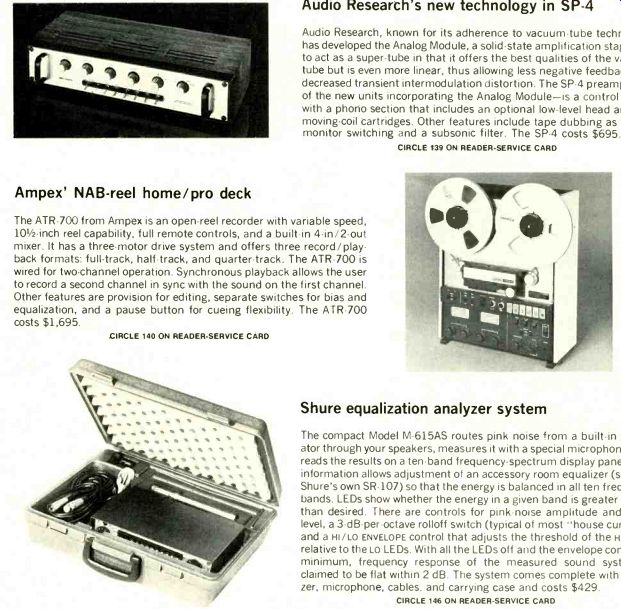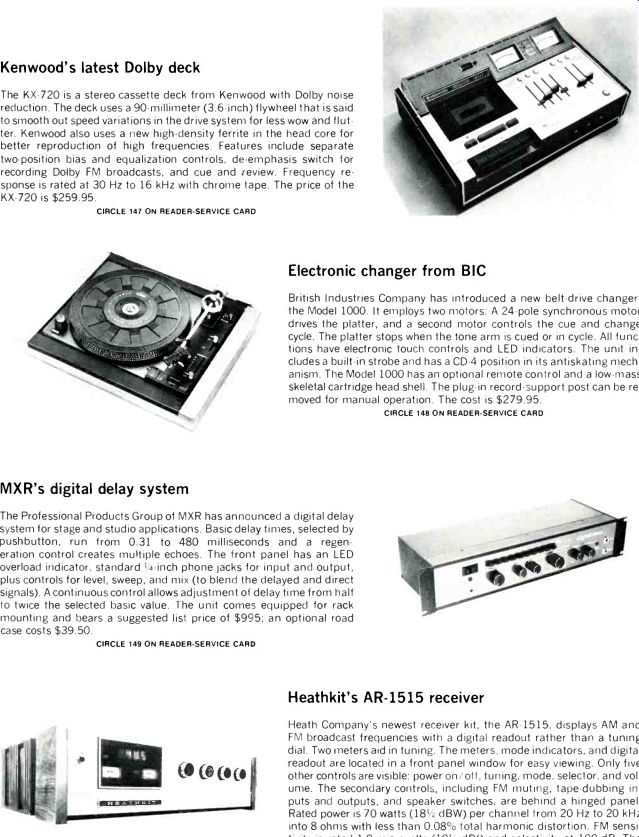
Audio Research's new technology in SP-4
Audio Research, known for its adherence to vacuum-tube technology, has developed the Analog Module, a solid-state amplification stage said to act as a super-tube in that it offers the best qualities of the vacuum tube but is even more linear, thus allowing less negative feedback and decreased transient intermodulation distortion. The SP-4 preamp-one of the new units incorporating the Analog Module-is a control center with a phono section that includes an optional low-level head amp for moving-coil cartridges. Other features include tape dubbing as well as monitor switching and a subsonic filter. The SP-4 costs $695.
Ampex' NAB-reel home/pro deck
The ATR-700 from Ampex is an open-reel recorder with variable speed, 10 1/2-inch reel capability, full remote controls, and a built-in 4-in /2-out mixer. It has a three-motor drive system and offers three record/play back formats: full-track, half-track, and quarter-track. The ATR-700 is wired for two-channel operation. Synchronous playback allows the user to record a second channel in sync with the sound on the first channel.
Other features are provision for editing, separate switches for bias and equalization, and a pause button for cueing flexibility. The ATR-700 costs $1,695.
Shure equalization analyzer system The compact Model M-615AS routes pink noise from a built-in generator through your speakers, measures it with a special microphone, and reads the results on a ten-band frequency-spectrum display panel. This information allows adjustment of an accessory room equalizer (such as Shure's own SR-107) so that the energy is balanced in all ten frequency bands. LEDs show whether the energy in a given band is greater or less than desired. There are controls for pink-noise amplitude and input level, a 3-dB-per-octave rolloff switch (typical of most "house curves"), and a HI /Lo ENVELOPE control that adjusts the threshold of the Hi LEDs relative to the Lo LEDs. With all the LEDs off and the envelope control at minimum, frequency response of the measured sound system is claimed to be flat within 2 dB. The system comes complete with analyzer, microphone, cables, and carrying case and costs $429.

Kenwood's latest Dolby deck
The KX-720 is a stereo cassette deck from Kenwood with Dolby noise reduction. The deck uses a 90-millimeter (3.6-inch) flywheel that is said to smooth out speed variations in the drive system for less wow and flutter. Kenwood also uses a new high-density ferrite in the head core for better reproduction of high frequencies. Features include separate two-position bias and equalization controls, de-emphasis switch for recording Dolby FM broadcasts, and cue and review. Frequency response is rated at 30 Hz to 16 kHz with chrome tape. The price of the KX-720 is $259.95.
Electronic changer from BIC
British Industries Company has introduced a new belt-drive changer, the Model 1000. It employs two motors: A 24-pole synchronous motor drives the platter, and a second motor controls the cue and change cycle. The platter stops when the tone arm is cued or in cycle. All functions have electronic touch controls and LED indicators. The unit includes a built-in strobe and has a CD-4 position in its antiskating mechanism. The Model 1000 has an optional remote control and a low-mass skeletal cartridge head shell. The plug-in record-support post can be re moved for manual operation. The cost is $279.95.
MXR's digital delay system
The Professional Products Group of MXR has announced a digital delay system for stage and studio applications. Basic delay times, selected by pushbutton, run from 0.31 to 480 milliseconds and a regeneration control creates multiple echoes. The front panel has an LED overload indicator, standard 1/4-inch phone jacks for input and output, plus controls for level, sweep, and mix (to blend the delayed and direct signals). A continuous control allows adjustment of delay time from half to twice the selected basic value. The unit comes equipped for rack mounting and bears a suggested list price of $995: an optional road case costs $39.50.
Heathkit's AR-1515 receiver
Heath Company's newest receiver kit, the AR-1515, displays AM and FM broadcast frequencies with a digital readout rather than a tuning dial. Two meters aid in tuning. The meters, mode indicators, and digital readout are located in a front-panel window for easy viewing. Only five other controls are visible: power on/off, tuning, mode, selector, and volume. The secondary controls, including FM muting, tape-dubbing in puts and outputs, and speaker switches, are behind a hinged panel.
Rated power is 70 watts (18 1/2 dBW) per channel from 20 Hz to 20 kHz into 8 ohms with less than 0.08% total harmonic distortion. FM sensitivity is rated 1.8 microvolts (10 1/2 dBf) and selectivity at 100 dB. The price of the AR-1515 is $549.95. Also available are kits for the AA-1515 amplifier section ($299.95) and the AJ-1515 tuner section ($379.95).
Bohsei deck offers bidirectional playback
The IT-1000, an open-reel tape deck from Bohsei Enterprise Company, U.S.A., has 10 1/2-inch reel capacity, three motors, full-logic solenoid-actuated tape motion, and mike and line inputs. Auto reverse, using a second playback head (for a total of four) provides up to 8 1/2 hours of uninterrupted playback. The transport operates at T 2 or 3 3/4 ips. At 7 1/2 ips, wow and flutter is rated at 0.06%, signal-to-noise ratio at better than 55 dB, and frequency response at 30 Hz to 20 kHz, +-3 dB. The IT-1000 costs $1,075.
New power-display system in 2400L SAE's power amplifier, the 2400L, has a new power-display system that reads output in 3-dB steps from 40 milliwatts (-14 dBW) to 200 watts (23 dBW) per channel plus overload. Response imbalances and imaging are indicated immediately by the amp's fast-response circuitry. Power indication is said to be accurate even at the lowest levels. The amplifier is basically the SAE 2400, rated at 200 watts (23 dBW) per channel with less than 0.05°. distortion. Signal-to-noise ratio is rated at better than 100 dB. The 2400L, which is designed for stability even with the most reactive loads and includes a feedback level control that does not affect noise level, frequency response, or input impedance, sells for $800.
Monitor-head cassette deck from Technics
The RS-99000S from Technics is a cassette system divided into two separate stackable units. One houses the tape transport, the other the electronics. The transport has a three-motor, dual-capstan, closed-loop drive. Separate recording and playback heads permit maximum play back performance and tape monitoring. The transport has Dolby noise reduction, peak-reading meters, and a calibration oscillator for Dolby level and head azimuth adjustments. A tape-timer meter indicates in minutes how much program time is left on the cassette. Pitch control allows adjustments in tape speed over a range of t 5%. Frequency response is rated at 20 Hz to 20 kHz with chrome tape, wow and flutter at 0.04%. The price of the RS.9900US is $1.500.
Sansui's newest receiver
The 9090DB is the top model in Sansui's current receiver line. Dolby decoding for FM is provided, as well as encoding and decoding for use with non-Dolby tape decks. The front panel features triple tone controls, two headphone jacks, high and low filters, and a -20-dB muting switch. In puts are provided for two tape decks, two turntables, and aux, and the receiver can handle up to three pairs of speakers. Rated power is 125 watts (21 dBW) per channel from 20 Hz to 20 kHz into 8 ohms with no more than 0.1% total harmonic distortion. The 9090DB costs $750.
-------------
(High Fidelity, March 1977)
Also see:
Equipment Reports: Kenwood 600-T tuner; Pickering XSV-3000 phono cartridge; Akai GXC-570D cassette deck; Garrard GT-55 turntable; Teac Esoteric Series Model PC-10 cassette deck